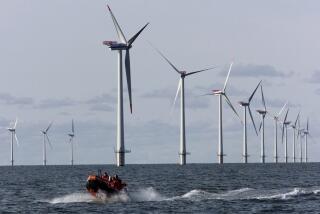Google invests $55 million in Mojave Desert wind farm
- Share via
Google Inc. is investing $55 million in a large Mojave Desert wind farm, pumping fresh air into California’s struggling wind power industry.
The Internet search giant made the announcement in Anaheim at the industry’s largest gathering, where wind farm developers and turbine makers said the investment could be a key step in California’s efforts to regain its once enviable title as the world’s capital for wind power.
“We just fell off a cliff,” said Gary Polakovic, a consultant for San Diego wind energy developer EnXco Inc. “But all eyes are on California now. It’s our chance to do this right.”
Google said Tuesday that it was partnering with Citibank, which is also shelling out $55 million to help finance part of the Alta Wind Energy Center, one of the world’s largest wind installations.
When complete, the project in the Tehachapi Mountains will generate 1.5 gigawatts, enough to power 450,000 homes. The installation will help boost wind jobs in the state 20% while feeding more than $1.2 billion into the Kern County economy, according to developers.
The project stands in stark contrast to the state of wind turbines in California.
In the industry’s early years, California led the way, with its turbines generating 90% of the world’s wind power as thousands of massive propellers dotted mountains from Palm Springs to San Francisco.
But in recent years, California — hurt by permitting delays and expiring government incentives — has seen its share of the world’s wind power plunge to 1.6% as other states and countries bolstered their alternative energy projects, according to the Global Wind Energy Council. The state gets just 3% of its electricity from wind, compared with 15% in Iowa and 8% in Texas.
“We stalled and fell behind,” said Lorelei Oviatt, planning director for Kern County. “It’s not just where the wind blows — if it were that simple, everyone would be happy.”
California’s woes have been a magnified version of the troubles facing the national wind industry, analysts said.
Last year, the market was “in distress,” said Denise Bode, chief executive of the American Wind Energy Assn., the trade group that organized the Anaheim conference. The amount of generation capacity installed was half the amount of the year before. The U.S. trailed China in 2009, even though it was a record year, and was eclipsed again in 2010.
Things are still looking “pathetic,” said Jonathan Kim, a power and utilities analyst with Royal Bank of Scotland. Attempts by inexperienced real estate developers and farm owners to launch wind projects have failed by the thousands, he said.
“Sales are low, everyone’s stock is depressed, and we’re seeing a lot of people struggling,” Kim said. “It’s just not a good time for the sector.”
Unpredictable government incentives that expire every year or two are a major culprit, he said. A substantial federal tax credit is set to end in January, and investors fear that it won’t be renewed.
Critics have also ramped up complaints that turbines are noisy eyesores that kill birds and reduce property values.
But even in such a sour environment, many analysts and industry officials said California is poised to return to its heady days.
The state is hosting the wind conference for the first time since 2007. The confab at the Anaheim Convention Center is expected to draw 20,000 people, up from 7,000 four years ago.
Big tech companies such as Google, with its massive data centers that need huge amounts of electricity, are helping refuel the industry. Google has pumped at least $400 million into alternative energy projects, including an Oregon wind farm and an offshore transmission project on the East Coast. The company has also plunged $168 million into BrightSource’s Ivanpah solar installation.
The industry could also benefit from a new clean power standard, the most aggressive one in the country, signed by Gov. Jerry Brown last month. The legislation, which requires California’s utilities to get 33% of the electricity they sell from renewable sources by 2020, has already led some companies to open new offices in the state.
In Kern County, saddled with 17.5% unemployment, wind is fast becoming one of the best hopes for jobs and tax revenue. Turbines taller than the Statue of Liberty are popping up in the Tehachapis, part of ambitious projects such as the Alta installation. Major efforts are also underway in the state’s Sonoma and San Gorgonio regions.
“We’re seeing this as a renaissance of California’s lead in the wind sector,” Bode said.
More to Read
Inside the business of entertainment
The Wide Shot brings you news, analysis and insights on everything from streaming wars to production — and what it all means for the future.
You may occasionally receive promotional content from the Los Angeles Times.











